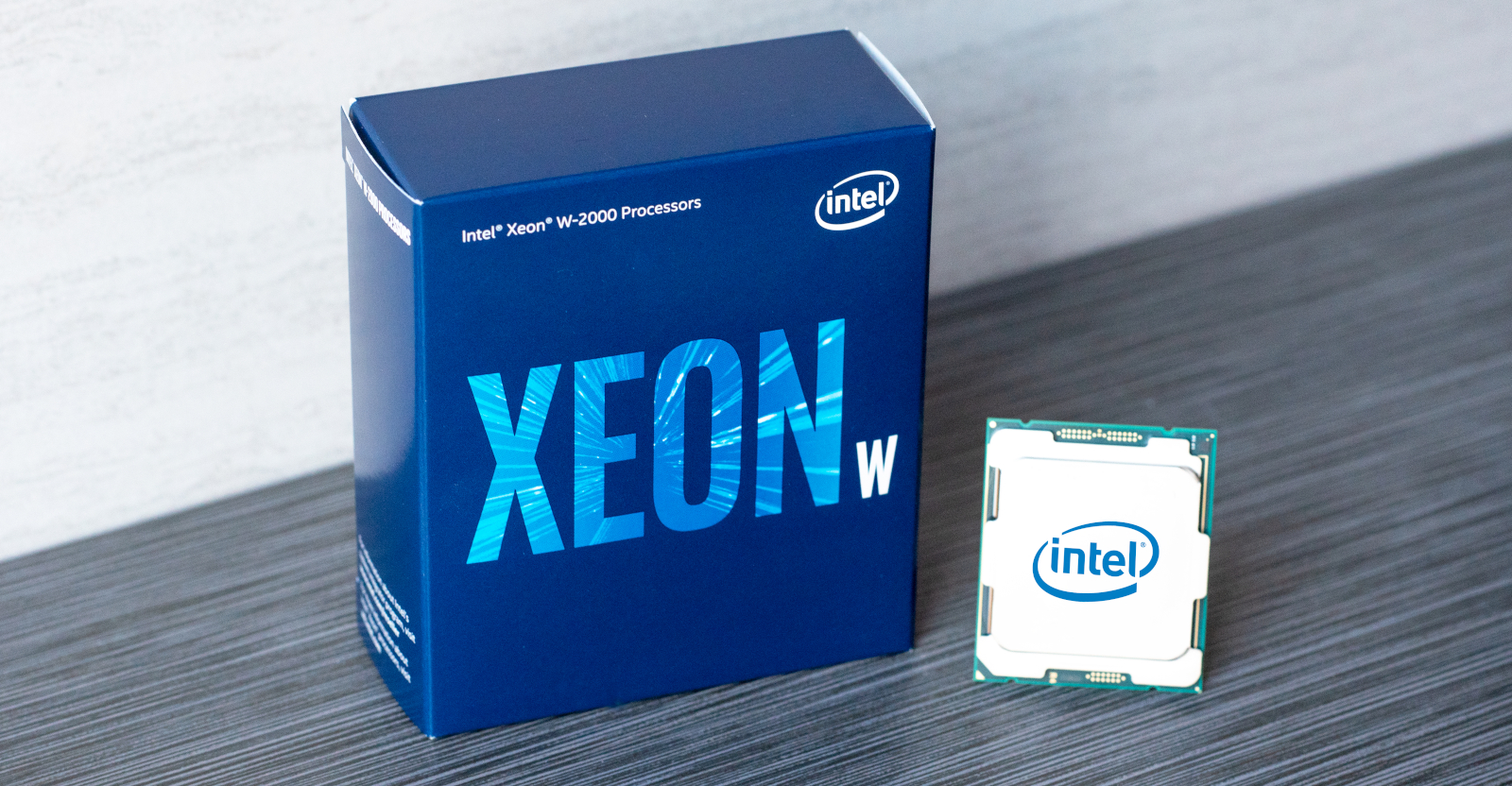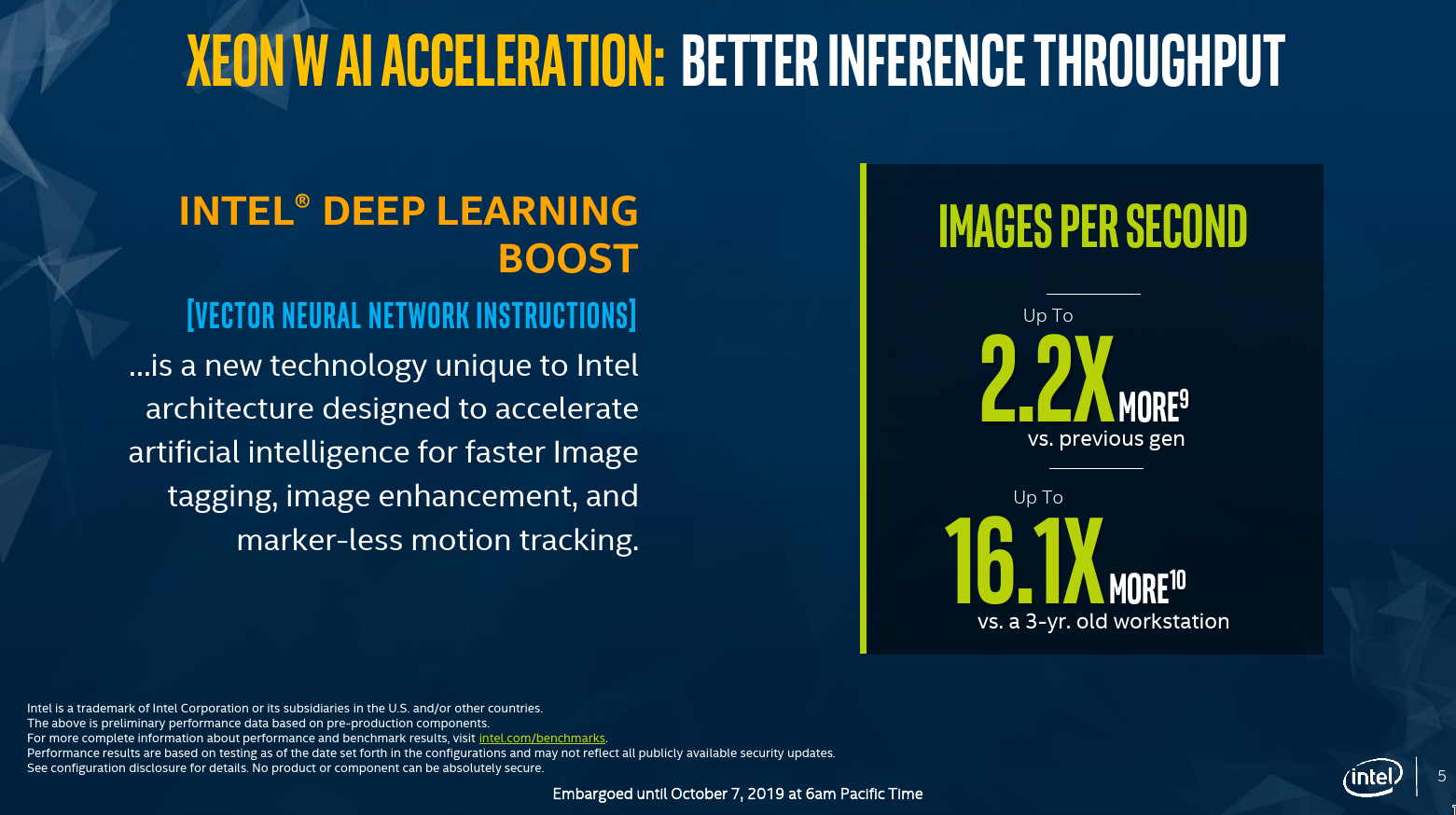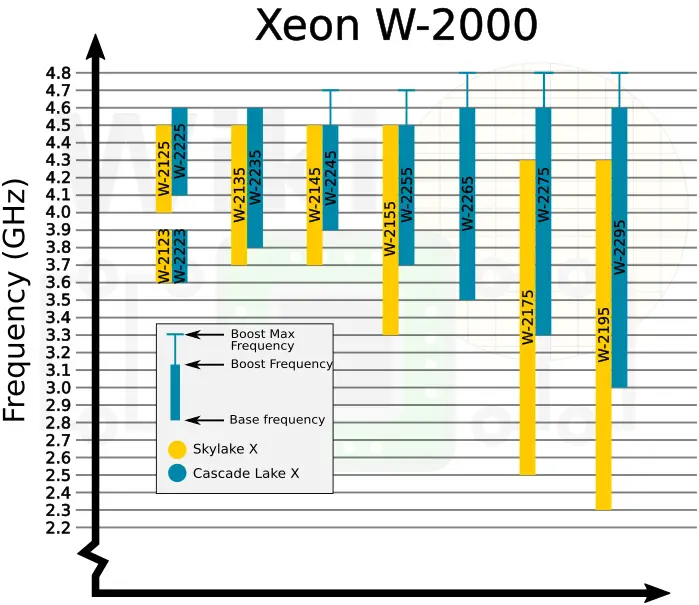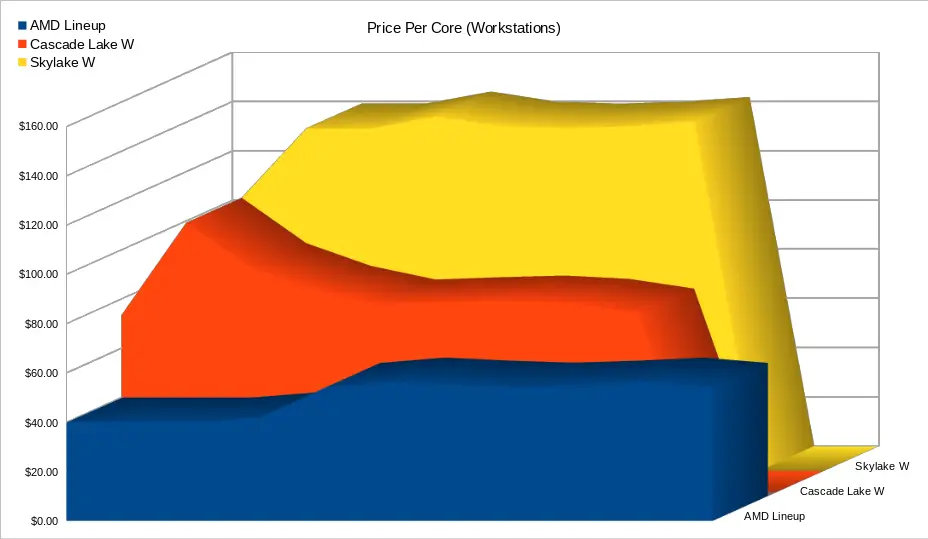Intel Launches Mainstream Cascade Lake Xeon W Workstation Processors
Today, Intel is launching its new Xeon W processors. Intended for the workstation and professional creators market, the Xeon W-2200 series processors are based on the Cascade Lake microarchitecture. The new series is a direct successor to the Skylake W which was introduced in August 2017, missing the usual yearly release cycle cadance.
The W-2200 processors are workstations processors and come with the usual bells and whistles for this market from Intel such as vPRO, RAS, VROC, and ECC support. At the platform level, up to 72 PCIe Gen 3 lanes are offered – x48 from the processor itself and x24 more carved from the PCH I/Os. Two new features that were added in this round is DL Boost which is the AVX512-VNNI extension which was added to Cascade Lake for the acceleration of inference workloads and Turbo Boost Max 3.0 (TBMT). Interestingly, no Optane DC persistent memory support is available for those processors.
W-2200 Vs. W-3200
Some of our readers might remember that in June we published an article about the introduction of Xeon W processors based on Cascade Lake. The series that was launched in June is the Xeon W-3200 series which is considered Intel’s high-end tier workstation series. The new W-2200 series is the mainstream workstations and is positioned slightly below the W-3200 series in the product stack. There are a few, subtle but important differences between the two series.
| Xeon W-2200 vs. W-3200 | ||
|---|---|---|
| Series | Xeon W-2200 | Xeon W-3200 |
| Microarchitecture | Cascade Lake | |
| Platform | FCLGA-2066 | FCLGA-3647 |
| Price Range | $294 – $1,333 | $749 – $7,453 |
| TDP Range | 105 W – 165 W | 160 W – 205 W |
| Cores (Threads) | 4 (8) – 18 (36) | 8 (16) – 28 (56) |
| Memory | 4x DDR4-2933 | 6x DDR4-2933 |
| PCIe Lanes | 48 | 64 |
| Max Turbo | 3.9 GHz – 4.6 GHz | 4.0 GHz – 4.4 GHz |
| Turbo Max | 4.7 GHz – 4.8 GHz1 | 4.2 GHz – 4.6 GHz |
- 1 – not all SKUs have TBMT 3.0
From the table above you can see that the Xeon W-2200 is substantially cheaper across the board. The Xeon W-3200 Socket P (FCLGA-3647) is the same socket as the mainstream Xeon platform which is how they can offer 6 memory channels and 64 PCIe lanes. The Xeon W-2200 continues to use the enthusiasts platform (FCLGA-2066) which is limited to four memory channels. Note, however, that despite more memory channels, with the exception of the more expensive ‘M’ SKUs on the 3200-series, both series support a maximum of 1 TiB of memory so the benefit comes in terms of bandwidth and performance for memory-bound workloads, but not memory capacity.
New SKUs
There are eight new SKUs ranging from four to eighteen cores.
| Xeon W-2200 Processors | |||||||
|---|---|---|---|---|---|---|---|
| Model | Price | C / T | TDP | Frequency | |||
| Base | Turbo Boost | Turbo Max | |||||
| Single Core | All Core | ||||||
| W-2295 | $1,333 | 18 / 36 | 165 W | 3.0 GHz | 4.6 GHz | 3.8 GHz | 4.8 GHz |
| W-2275 | $1,112 | 14 / 28 | 165 W | 3.3 GHz | 4.6 GHz | 4.1 GHz | 4.8 GHz |
| W-2265 | $944 | 12 / 24 | 165 W | 3.5 GHz | 4.6 GHz | 4.3 GHz | 4.8 GHz |
| W-2255 | $778 | 10 / 20 | 165 W | 3.7 GHz | 4.5 GHz | 4.3 GHz | 4.7 GHz |
| W-2245 | $667 | 8 / 16 | 155 W | 3.9 GHz | 4.5 GHz | 4.5 GHz | 4.7 GHz |
| W-2235 | $555 | 6 / 12 | 130 W | 3.8 GHz | 4.6 GHz | 4.3 GHz | – |
| W-2225 | $444 | 4 / 8 | 105 W | 4.1 GHz | 4.6 GHz | 4.5 GHz | – |
| W-2223 | $294 | 4 / 8 | 120 W | 3.6 GHz | 3.9 GHz | 3.7 GHz | – |
Frequencies
Since Intel did not refresh the Xeon W from the original Skylake processors, the new SKUs had more headroom to grow in frequency. Intel exploited that fairly significantly on the high core-count SKUs. The table below compares equivalent SKUs between the W-2100 and W-2200 series. Notice that although there is a 100-200 MHz base frequency improvement in the low core-count SKUs, there is a 400 MHz and even a 700 MHz improvement on the 14- and 18-core SKUs. Likewise, with the turbo boost, it’s the high core-count SKUs that see a 300 MHz improvement.
On top of the usual base and turbo boost frequencies Intel added Turbo Boost Max 3.0 (TBMT). TBMT 3.0 was previously only offered on the enthusiests lineup. The feature is now making its way to the Xeon W processors. Here, TBMT 3.0 comes with more improvements. As with the Core X processors which were launched last week, Intel is increasing the affected cores to four. Based on the stochastic properties of the die, the best four cores are chosen. The two most superior cores enjoy the full TBMT frequency with the two remaining cores capable of boosting up to 100 MHz lower. The change is intended to cover more use cases and should have a noticeable impact on user experience and highly burst and sparse operations.
Pricing – Improvement In Perf/Dollar
Last week Intel launched the Core X family based on Cascade Lake and the most major improvement is in the performance-per-dollar which almost doubled across the entire lineup. We see a similar improvement with the new Xeon W-2200 series. The biggest improvement is on the 18-core SKU which is half the price of its predecessor.
| Gen-Over-Gen Changes | |||||||
|---|---|---|---|---|---|---|---|
| Previous Generation | → | Current Generation | Δ | ||||
| Model | Price | C/T | → | Model | Price | C/T | |
| W-2123 | $294 | 4 / 8 | → | W-2223 | $294 | 4 / 8 | 0 (0.0%) |
| W-2125 | $444 | 4 / 8 | → | W-2225 | $444 | 4 / 8 | 0 (0.0%) |
| W-2135 | $835 | 6 / 12 | → | W-2235 | $555 | 6 / 12 | -$280 (-33.53%) |
| W-2145 | $1113 | 8 / 16 | → | W-2245 | $667 | 8 / 16 | -$446 (-40.07%) |
| W-2155 | $1440 | 10 / 20 | → | W-2255 | $778 | 10 / 20 | -$662 (-45.97%) |
| – | → | W-2265 | $944 | 12 / 24 | N/A | ||
| W-2175 | $1947 | 14 / 28 | → | W-2275 | $1112 | 14 / 28 | -$835 (-42.89%) |
| W-2195 | $2553 | 18 / 36 | → | W-2295 | $1333 | 18 / 36 | -$1220 (-47.79%) |
In terms of price-per-core, the higher core count SKUs are far more attractive than the low core-count SKUs. There could be a couple of explanations as to why this is. With AMD and Intel competing with increased core count in the mainstream desktop market, four cores have been reduced to the low-end performance Core i3 processors with Core i5 having six cores. The Coffee Lake-base Core i3 processors range from $122 to $175 while the Core i5 processors are priced from $180 to $265. Therefore, if Intel lowers the 4/6-core Xeon W processors any further, it will compete well with the Core i3/i5 families. This also explains why the W-2223 and W-2225 are priced identically to last-gen SKUs. Additionally, it’s possible that this pricing structure is simply designed to incentivize customers to move up the stack to more expensive high core-count parts.
–
Spotted an error? Help us fix it! Simply select the problematic text and press Ctrl+Enter to notify us.
–






